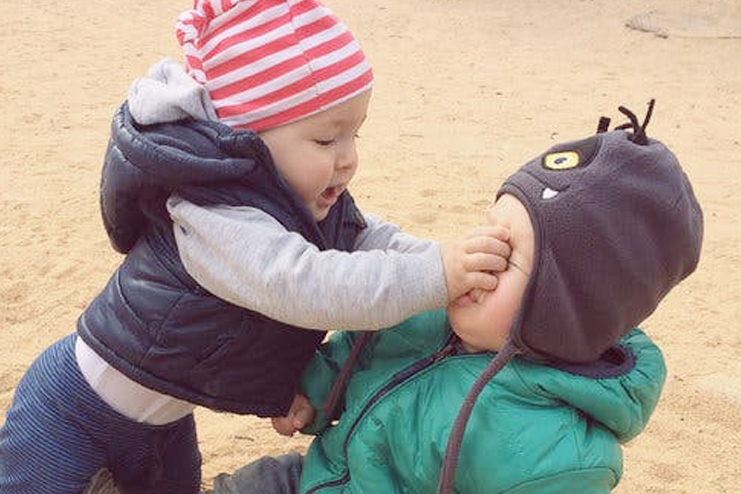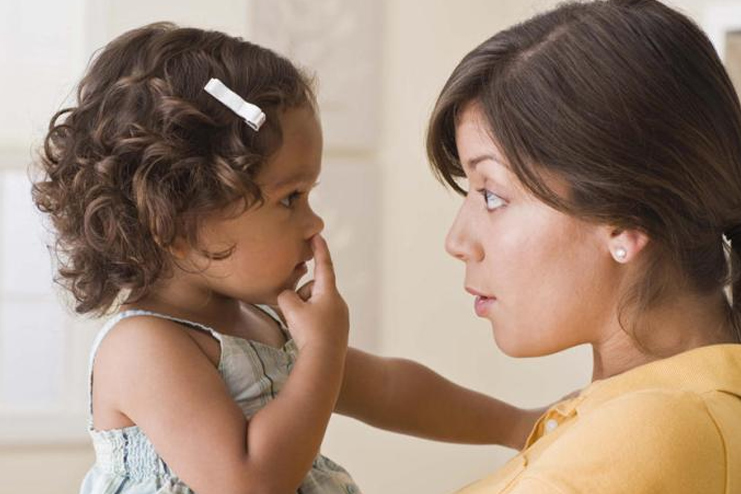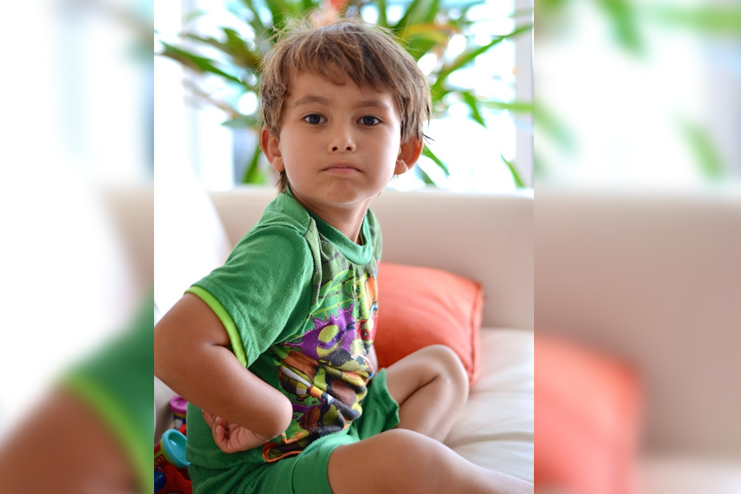Do your kids hit other children? Is it sometimes embarrassing for you? Why do your kids get aggressive? How should you respond to it? Well, I know all these questions must be arising in your mind!! The answer to all of these is toddler tantrums.
Most of the time the toddlers get aggressive and show aggressive behavior such as hitting, (R) kicking, scratching, biting, etc. This doesn’t necessarily make your child bad, it might be the situation they are faced with. It is a part of their developmental phase.
By the end of the article, you will come to know the ways to stop a toddler from hitting and the ways to deal with toddler hitting.
Why Do Toddlers Hits Others?

It is quite normal and common for the toddlers to hit their parents during tantrums. They hits others too. It is a part of their developmental stage. The toddlers hit because of being frustrated, impulsive and unable to voice their feelings.
This doesn’t mean they are bad or disobedient. They show such tantrums when they are trying to tell you something, and haven’t yet developed the language skills or emotional habits to communicate more effectively.
“Toddlers do not have much control over their emotional impulses and are still developing language skills,” explains Catricia Tilford, MD, a board-certified pediatrician affiliated with Rowedocs Telemedicine Network.
Some times out of curiosity, the toddler tries to hit others as they have the curiosity to learn things or do. They like to experiment with a lot of things and have inquisition to know why it is wrong to hit somebody.
It is also said that children learn a lot of aggressive behavior by imitation and may have seen their sibling or other children hitting somebody and copied the behavior which results in negative outcomes like hitting, kicking, scratching, biting, etc.
You can read also: How to Deal with Anger management in Kids
How to Stop Toddler From Hitting:

1. Analyze The Underlying Reasons
It is not wise to take it personally as the babies do bite the hands and the nipples that feed them. Everything babies do revolve around their hands and mouth.
The hands and teeth square measure their initial social tools, and that they find out how to use them from the responses they get.
As shortly as teeth erupt and hands flap, babies experiment and use these instruments on completely different objects to visualize how it feels.
These early nips and slaps, as awful as they look and feel, are playful communications, not aggressive, disrespectful conduct.
Aggressive biting and hit are quite common between the ages of 18-months and 2½ years when the kid doesn’t have the verbal language to speak his wants. Instead, he communicates through actions. Biting typically stops because the child’s verbal skills grow however hit doesn’t.
2. Note The Triggers:
Make sure you note of the reasons that trigger hitting and biting as it helps you understand your child’s aggressive behavior. For instance, Roxy thinks Harley’s toys are better than his. He takes Harley’s toys and wouldn’t give them back. So, Harley hits Roxy to take back his toys.
It is the parents who can resolve the situation by telling Roxy that his toys are good too. And that Harley must learn to share his things. This could help avoid such incidents in future.
3. Provide Alternatives:
A socially incorrect gesture babies experiment with is face slapping.
Redirect the hitter into a socially-acceptable alternative: “Give me five” Likewise, direct nipping: “No biting, ouchie, hurts Mama! Then direct the behavior: “Hug mama.”
Once your child’s face-slapping becomes aggressive as the nursing expression of frustration, you’ll have to show her the natural consequence. Firmly however sedately announce “You might not hit” and place her down.
She’ll still be angry regarding the candy, thus you’ll be able to verbalize that for her. Do not enable your toddler to use you as a punching bag.
Give her the message that you just won’t let her hurt you.
If you don’t enable your kid to harm you once he’s terribly young, he is going to be less doubtless to let others hurt him once he’s older.
You will be modeling him a way to say “no” to being hit, for instance, by holding up a hand to stop the blow but not hit back.
If your one-and-a-half-year-old bangs his toy hammer on the heads of alternative babies within the cluster, take away all objects that he will hit with. Show and tell him to not hit and provide him another gesture: “Be nice, pat baby” as you gently guide his patting hand.
4. Don’t Bite Back:
The child needs to learn that biting hurts. The most important thing the baby should know there is no need to bite them back. In this way, try the alternative way of the tooth for tooth method.
Give the lesson immediately after the child bites you or others. Make your child learn how to be sensitive to how others feel – an early lesson in empathy.
5. Be Empathetic:
You notice one kid hits (pushes or kicks) another to urge a toy.
Show and tell others, “We don’t hit other people. When I wish one thing from you I don’t hit you, I raise you nicely.”
If the hitter doesn’t work, raise the victim to mention, “I’m not fiddling with you anymore till you say you’re sorry and stop touching.”
Two-year-olds might not be able to say these words, however, they’ll perceive them; thus you say the words for them and follow through with the consequence. Also, impress upon the biter: “How would you’re feeling if Tommy bit you.”
6. React Immediately:
An immediate action or reaction has to be taken when hitting happens. Whenever you see the little hands go up, try to stop by not shouting loud, just be firm in your response.
Look them in the eye and tell him no hitting or that hurts. This would indicate that you mean business. Take him away from the situation to a place he likes and help him calm down.
7. Distract the Little One:
Taking away the problem object is one of the ways to get a toddler to stop hitting. So, try to distract the child with something that interests them.
8. Reward Positive Behavior
Children over 3 respond well to rewards, like a no-hitting chart:
“Every day you’re nice to your friends, place a cheerful face on the chart. When you have 3 happy faces we’ll withdraw to lunch along.”
9. Program Self-Control:
Some impulsive children hit before they think. For children over 3, facilitate them manage these impulses by suggesting substitute behaviors that the kid clicks into at the primary thought of hitting:
“As before long as you’re feeling to hit, grab a pillow and pound on that or go run across the yard.” This will be able to model impulse management for your kid.
10. Don’t Confuse:
When you hit your child and tell him that he can’t hit other children, you are only confusing him by doing what shouldn’t be done. You can’t expect him to follow something you are not following. So, never hit to enforce discipline.
11. Be Consistent:
Be consistent when you are enforcing a rule. Whenever he hits, discipline him and tell him not to do so. He should be disciplined even if he hits someone out of fun.
12. Avoid Setups
Avoid things that bring out the worst in children. At a celebration, a mother set up a scavenger look for a bunch of boys within her house, of all places. To fuel the craze, she offered a prize for the winner.
You can imagine what happened. Both the house and also the youngsters were a wreck.
They hit and shoved each other and trashed the house in pursuit of the hidden treasures. Bruised skin and bruised feelings resulted in the end.
13. Encourage Gentle Play
Do you find your child routinely banging toys, bashes dolls, kicks cats, and pounds on walls? While a number of this acting out is traditional, it can be a red flag for tension and anger.
The child is in danger of treating humans in this manner. Besides delving into the roots of the matter, encourage a lot of mild play: “Hug the bear,” “Pet the kitty,” “Love the doll.”
14. Talk and Explain:
It is seen that children understand better through examples and the more you speak and talk to them. Open communication is one of the major parts of stopping the toddler from hitting.
Make sure you answer and reply to their action. Don’t make them confused. They should know why not to hits others. This will gradually help them to develop their social skills.
15. Use Time Out to Calm The Situation:
Biting hurts, and it’s wrong to hurt are some of the things the kids should know. You are going to sit by me. Usually by two years of age the child can make the connection between being aggressive and the consequences. So encourage your child to say “I’m sorry.” If he’s not angry anymore, he might want to give a kiss or hug.
How Long Does Toddler Hitting Phase Last?

As per studies, the period of toddler development between 18 and 36 months can be a time of extremes. One minute children may be cuddly and cooperative and the next minute assertive and contrary.
By the age of 2, at this stage, children are typically beginning to feel their power. “No” is a very powerful word that gets adults attention. Mostly the toddler hitting phase lasts up to 2-3 years of age.
As I said above also that most of the time the toddlers get aggressive and shows aggressive behavior such as hitting, kicking, scratching, biting, etc. There is nothing bad about your child. It is a part of their developmental phase.
Strategies For Dealing With Toddler Hitting:
There are certain strategies for dealing with toddler hitting and challenging toddler behavior. Some of the ways are-
1. Understand the Triggers:
Understand what triggers such behavior in your toddler and that helps you to deal with the toddler hitting. It could be hunger, fatigue, or need for power so you need to understand that particular trigger at that time.
It is very much important and necessary to address those needs and wants. Most often the kids are unaware of their requirements, so you could be able to figure out them understand those issues.
2. Guide them:
Guiding the child behavior is an important aspect for dealing with toddler hitting. It is important to help them improve the situation. In such situations, guide them with love and kindness to learn and explore other things and emotions.
3. Don’t Give Immediate Attention:
It is seen that most of the time, the toddler wants to seek your attention by hitting. So, therefore, don’t react immediately. Instead, comfort the hurt child first. Just be a role model to your child by being compassionate to the victim. Make sure you convey a message that hitting doesn’t get your attention at all at least for that set of time.
4. Give Options:
There is evidence that certain parents do not give options to the kid, and just instruct them on what is to be done. They are more dominating and authoritative parents. If parents provide more options and control to the child, it prevents hitting and aggressive behavior.
It is quite normal that toddler will hit, bite, throw and show a lot of tantrums at this particular age. But this all doesn’t make a conclusion that he/she is a bad child. It is common and goes after a certain phase of development. So, I hope this article has given you a good amount of information about the ways to deal with toddlers from hitting and stopping the toddler from hitting.








































